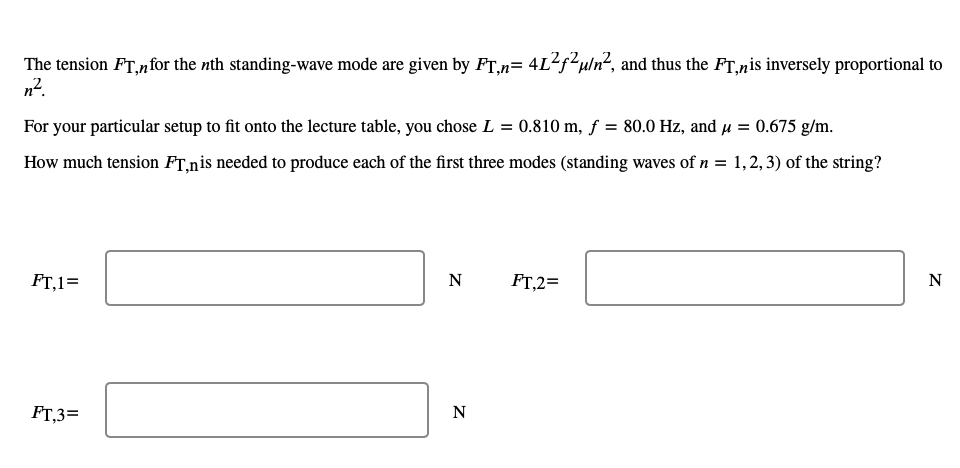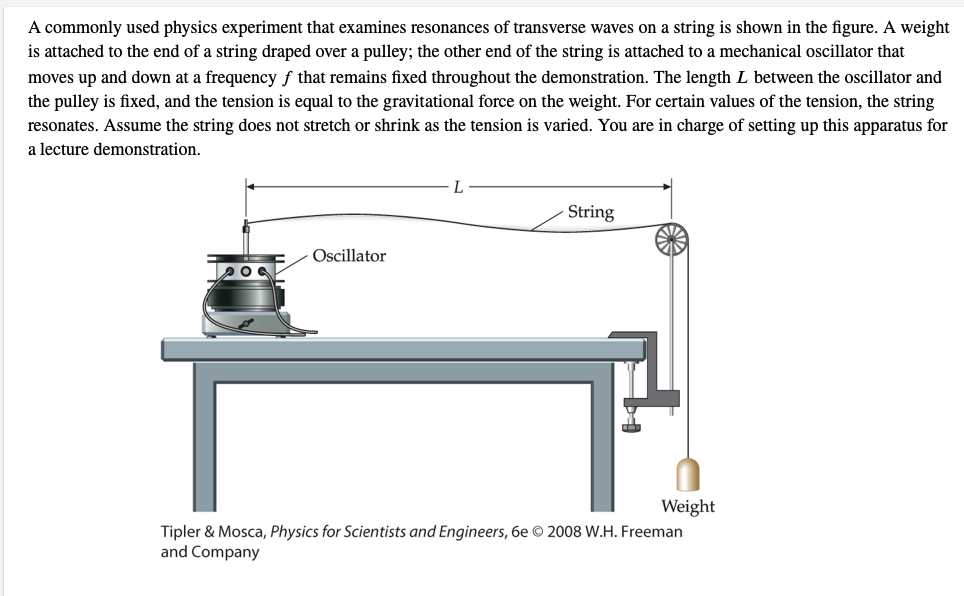The tension FT,n for the nth standing-wave mode are given by FT,n= 4L²f²µ/n², and thus the FT,nis inversely proportional to n². For your particular setup to fit onto the lecture table, you chose L = 0.810 m, ƒ = 80.0 Hz, and µ = 0.675 g/m. How much tension FT,nis needed to produce each of the first three modes (standing waves of n = 1,2,3) of the string? FT,1= FT,3= N N FT,2= N
The tension FT,n for the nth standing-wave mode are given by FT,n= 4L²f²µ/n², and thus the FT,nis inversely proportional to n². For your particular setup to fit onto the lecture table, you chose L = 0.810 m, ƒ = 80.0 Hz, and µ = 0.675 g/m. How much tension FT,nis needed to produce each of the first three modes (standing waves of n = 1,2,3) of the string? FT,1= FT,3= N N FT,2= N
Related questions
Question
A commonly used physics experiment that examines resonances of transverse waves on a string is shown in the figure. A weight is attached to the end of a string draped over a pulley; the other end of the string is attached to a mechanical oscillator that moves up and down at a frequency ? that remains fixed throughout the demonstration. The length ? between the oscillator and the pulley is fixed, and the tension is equal to the gravitational force on the weight. For certain values of the tension, the string resonates. Assume the string does not stretch or shrink as the tension is varied. You are in charge of setting up this apparatus for a lecture demonstration.
1. Why do only certain discrete values of the tension result in standing waves on the string?
2. Do you need to increase or decrease the tension to produce a standing wave with an additional antinode? Explain.

Transcribed Image Text:The tension FT,for the nth standing-wave mode are given by FT,n= 4L²f²u/n², and thus the FT,nis inversely proportional to
n².
For your particular setup to fit onto the lecture table, you chose L = 0.810 m, f = 80.0 Hz, and μ = 0.675 g/m.
How much tension FT,nis needed to produce each of the first three modes (standing waves of n = 1,2,3) of the string?
FT,1=
FT,3=
N
N
FT,2=
N

Transcribed Image Text:A commonly used physics experiment that examines resonances of transverse waves on a string is shown in the figure. A weight
is attached to the end of a string draped over a pulley; the other end of the string is attached to a mechanical oscillator that
moves up and down at a frequency fƒ that remains fixed throughout the demonstration. The length L between the oscillator and
the pulley is fixed, and the tension is equal to the gravitational force on the weight. For certain values of the tension, the string
resonates. Assume the string does not stretch or shrink as the tension is varied. You are in charge of setting up this apparatus for
a lecture demonstration.
Oscillator
L
String
Weight
Tipler & Mosca, Physics for Scientists and Engineers, 6e © 2008 W.H. Freeman
and Company
Expert Solution
This question has been solved!
Explore an expertly crafted, step-by-step solution for a thorough understanding of key concepts.
Step by step
Solved in 5 steps
